Education, MY Classroom
EPIC Indoor Activities and Games List! Beat Boredom and Boost Learning!
Yet another post coming to you with the advisory to make a cup of tea or coffee before reading!
Welcome to Part 2 of our non screen-based activity guide. (See Part 1: Gross Motor Skills and Outdoor Activities here). In this post, we look closely at fine motor skills development and concentrate (mainly) on tabletop activities that can be done inside.
Fine motor skills refers to the coordinated use of the small muscles of the body (hands, wrists, fingers, feet, toes, lips, and tongue). Sometimes the terms ‘dexterity’ or ‘hand-eye coordination’ are used when referring to fine motor skills. You may find this fine motor skills checklist useful for children up to 8 years of age.
The following suggestions may be helpful if you would like to specifically target fine motor skills. Later in this post, there are lots of more general activity ideas for you to try.
Fine Motor Activities
To boost fine motor skills, try some of the following activities:
With both the dominant and non-dominant hand, can the child…
-
make a fist and then fan out and wiggle their fingers?
-
clench their fists tightly and lightly?
-
bend and straighten fingers one at a time?
-
use a pincer grip to squeeze each finger of the opposing hand?
-
rotate wrists clockwise / anti-clockwise?
Using a scissors, can your child…
-
snip a fringe around the edge of a page (light card and paper)?
-
cut along rows of various short lines (3 – 5 cm approx.)
-
cut along longer curved lines?
Using play-doh, can your child…
-
roll out ‘snake’ shapes?
-
mould the dough into various shapes by pinching, prodding, squeezing etc.?
-
create dough balls of various sizes? Can your child squeeze them? Can your child flatten them? Can they pinch off small pieces?
To develop pincer grip and hand-eye coordination, can your child…
-
pick pom-poms up, using pincer grip, and place one in each section of an ice-cube tray? Repeat activity with other small objects, e.g., blocks, buttons, elastic bands, beads, rice grains etc.
-
pop the bubbles on bubble wrap?
To develop threading, can your child…
-
thread beads or cereal hoops onto string or ribbon?
-
thread pipe-cleaners through the holes in a colander?
With paper, can your child…
-
tear paper and card, creating large strips and tiny pieces?
-
fold paper into smaller and smaller pieces?
With paper clips, can your child…
-
attach paper clips to paper?
With stickers and tape, can your child…
-
peel stickers off backing paper?
Using a hole punch, can your child…
-
punch holes in different materials, e.g. paper, card, and felt?
Using building blocks, can your child…
-
build a tower of 9 – 10 (non-interlocking) blocks?
-
create a block pattern for a friend to copy?
-
build the highest Duplo/Lego tower they can?
Using marbles, can your child…
-
pick up and hold one marble and then another? What is the maximum number the child can pick up and hold at one time? Does it differ between the dominant and the non-dominant hand?
Using puzzles, can your child…
-
complete jigsaw puzzles of increasing numbers of pieces?
-
pick up small board games pieces and move them with adequate pincer grip?
Using a variety of writing implements (e.g., pencils (of varying thickness), pens, markers, crayons, paintbrushes), can your child…
-
hold the page steady with the non-dominant hand while they draw?
-
fill a page with as many lines as possible?
-
draw circles, using clockwise and anti-clockwise motions?
-
draw the outline of their non-dominant hand?
-
draw around stencils and cookie cutters of various shapes? Cut these out.
With paint, can your child…
-
work with a variety of different implements to apply paint, e.g., fingers, sponges, paintbrushes of different sizes, lollipop sticks, cotton buds, and toothbrushes?
-
dab paint on paper with fingers, sponges, cotton buds and various paintbrushes? Do this, staying within lines?
-
create giant brush strokes using shoulder movements (gross motor)?
With masking tape, can your child…
-
Place the tape on the floor/ground/wall – over a straight line, a zigzag line or a curved line that you have drawn?
-
Can he/she later peel it off?
Using the taped line on the floor, can your child…
-
Walk along it as if on a balance beam?
-
Roll a marble and balls of different sizez along the taped line with 2 hands and then with right hand and left hand only.
-
Drive and reverse toy cars along it.
Can your child…
-
open bottles and fill with water from a jug at a water play station?
-
squeeze squirty bottles?
-
pour water from one container to another?
-
pick up items on a scoop or spoon, e.g. cotton balls, pom poms, or rice and transfer them to another tub?
-
spray the table with water and wipe it?
A more comprehensive list of fine motor activities can be found in Word for Word Book 1, our phonics series, available for purchase in the Dumond store.
Indoor Activities
Below you will find lots of indoor activity ideas for you to try during these current school closures.
Creativity
Remember our EPIC resource list contains suggestions for arts & crafts websites if you need inspiration, but it is likely nothing other than your child’s imagination and some art supplies are required (well perhaps some patience and deep-breathing too if it involves glitter and paint!) I also include some other useful links below.

Drawing and Colouring

Explore different media (pencils, wax crayons, oil pastels, markers etc.)
Craftwhack is a brilliant website with 100 drawing ideas for toddlers to teens as well as 50 sketchbook ideas, 10 of which I share below to give you can idea of just how good they are. Simple to do with few materials required – a win indeed!
-
Cut a rectangle out of a piece of paper, tape it to a window, and draw only what is inside of the rectangle
-
Trace around your hand and then go in and try to make it look like something other than a hand drawing
-
Make up some underwater creatures
-
Turn your initials into a drawing of some sort of food
-
Separate your entire page with 6 lines, then fill in the spaces with different patterns
-
Draw something using only dots
-
Big huge cartoon eyes
-
Write your name in the centre of the page, then draw things, people, ideas, whatever that you love around your name
-
Make a page full of copied logos
-
2 circles- shade one to look like a ball, and the other to look like a hole
A few other suggestions:
-
In some countries, a movement to write to one another during social distancing is beginning. In Ireland, for example, the national postal service will be delivering 2 free postcards to every household that can be written and sent to loved ones within the country (no stamp necessary). With that in mind, designing postcards or greetings cards and writing them could be another great activity.
-
When outdoors, use chalk to draw on the footpath.
-
Turn-Taking Drawing is a good activity to encourage cooperation between siblings or to keep a younger child occupied and busy while you work with an older one.
-
Option 1: Best done with a few people.
-
Cut an A4 sheet of paper in half lengthways.
-
Fold the page into thirds (folding top-to-bottom not side-to-side).
-
Each person draws a head in the top box, folding it over so it can’t be seen before passing it on to the next person who draws a torso.
-
Fold over again and pass once more to the final person who draws the legs.
-
Reveal the masterpiece and colour!
-
-
-
Option 2: Suitable for 2 or more persons
-
Person 1 begins by drawing something on a page (e.g., eyes, outline of a person, tree…absolutely anything) and passing the page to person 2.
-
Person 2 adds something to the drawing before returning it.
-
Continue until both are satisfied with the picture.
-
Painting

Experiment with different types of paints if you have them (poster paint, watercolours, acrylics etc.)
Try:
-
Painting pictures using different types of paints
-
Finger painting
-
Sponge painting
-
Blow painting
-
Splatter painting (with old toothbrushes)
-
Acrylic pours
-
Raised Salt Painting
-
On card, outline an image using PVA glue.
-
Cover the glue with salt tipping away the excess.
-
Paint with a brush and watered-down food colouring.
-
Allow to dry (up to 48 hours).
-
Jamie from Hands on as we Grow has compiled a detailed list of painting tools and methods you may wish to try. Ideas and inspiration may also be found at Projects with Kids.
Printing

We probably all remember adding paint to one half of a butterfly then folding over the page to copy the pattern onto the opposite wings. Printing can be lots of fun.
Try:
-
Fingerprinting – make lots of fingerprints. When dry, add details and turn them into pictures.
-
Printing with vegetables
-
Printing with leaves
-
Printing with bottle tops, wine bottle corks, bubble wrap, string, kitchen roll inserts (see Alisa Burke’s ideas).
-
Craftwhack’s printing with foam stickers
-
Sponge printing
-
Using stampers
Crafts

-
Happiness is Homemade has lots of craft ideas here.
-
You will also find many more at the Spruce Crafts.
-
With Mother’s Day in the UK and Ireland falling tomorrow (March 22nd). some children may like to try one of these Mother’s Day crafts from The Best Ideas for Kids this weekend.
Some other things to try:
-
Make a sun-catcher
-
Make a pattern using pieces of tissue paper, petals or leaves and place in between two pieces of sticky-back plastic.
-
Hang in the window and watch the sun shine through it.
-
-
Collage
-
Make a collage with scraps of paper
-
-
Make finger puppets
-
Origami
-
Make paper aeroplanes. Have a competition and see who in the family can fly their plane the farthest.
-
Try to learn to make something other than a paper plane out of paper!
-
-
Create frames (from coloured card / lollipop sticks) and mount and frame your artwork. Write labels to accompany the pictures and create an art gallery.
Sculpting

Use the following materials to create sculptures:
-
Play-doh (Also try making play dough!)
-
Clay
-
Pipe-cleaners
-
Lollipop sticks
-
Recycled materials – can you up-cycle a flower pot as in the image?
Film / Photography

-
Take close-up pictures of random objects around the house or in the garden. Can your child guess what they are looking at?
-
Allow them to be the photographer and you to guess what they have snapped.
-
Make a television show
-
Make a stock motion animation
-
Have a movie night – perhaps combining with a pizza and pyjama party.
Drama

Try:
-
Creating a play
-
Playing ‘Led by the ___’ – imagine you have strings attached to different parts of your body, e.g., you nose or your shoulders. Move about the room as though you are being pulled by that string.
-
Having your child walk in different styles – Walk like a mouse, lion, ballerina, model, as if you are in mud, as if your ankle is sprained etc. Can they come up with some suggestions to try?
-
Reading a story aloud and having your child perform some of the actions or freeze mid-act at a certain point in the tale.
-
Playing charades
-
Accents/Intonations- try saying the same phrase aloud in different accents or using different intonation. Can your child convey different emotions in this way?
-
Having a puppet show – make sock puppets or finger puppets and host a puppet show.
-
Playing slow motion games – pretend to play a sport in slow motion.
-
Hot-seating – either you or your child adopt the role of a character in a story or from history. When asked questions, you must answer them in role.
Fashion / Clothing
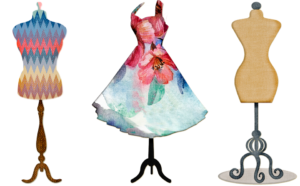
-
Add some new items to a dress-up box and have your child put on a fashion show.
-
Use fabric paints and re-design an old t-shirt.
-
Create sock puppets.
-
Make jewellery.
-
Make friendship bracelets.
-
Draw some new clothing designs.
Reading, Books and Storytelling

-
Be a librarian and organise your books. How will you categorise them?
-
Set yourself a reading challenge and track how many books you read while your school is closed. Make a note of how many pages are in each one and keep a running total of pages read!
-
Record yourself reading a story aloud.
-
Enjoy online or audio books.
-
Oral Storytelling. Take it in turns to add a line to a story. One person begins the story and then each person in turn adds a sentence.
-
Write a story.
-
Create your own cartoon.
Music and Song

-
Learn new songs
-
Practise instruments
-
Have a karaoke
-
Make a DIY instrument
-
Have a disco
-
Write their own song
-
Little Kids Rock have lots of free music lessons available.
Board Games and Puzzles
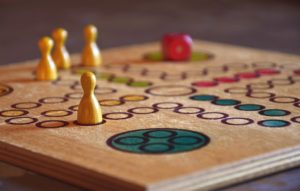
Great for promoting turn-taking and boosting logic and reasoning, dust off some games that haven’t been played for a while.
-
Can your child make their own board game?
-
Can your child complete a bigger jigsaw puzzle than they have ever done before!
Language Games
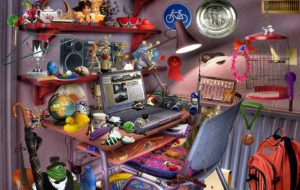
-
I Spy – I spy with my little eye something beginning with ___. Why not play this games using the image above?
-
Hang Man – 1 player draws lines representing each letter in the word/words. Fellow players have to guess letters. If correct, these are filled in. If incorrect, part of the hangman is drawn. Can the answer be found in time?
-
Rhyming Words: Choose a word and ask your child(ren) to think of as many rhyming words as possible.
-
Alphabet Game – Name things for each letter of the alphabet, e.g., foods, animals, places etc. Write the the letters on pieces of paper and choose one or use go/stop. Say go and someone recites alphabet in their head. Say stop and they tell you the letter they landed on.
-
Scattergories – Make a list of categories, e.g., sports stars, musicians and bands, places, foods, something you wear, body parts, something that moves etc. Choose a letter (write them all on pieces of paper and select one or use go/stop. Say go and someone recites alphabet in their head. Say stop and they tell you the letter they landed on.) Set a timer (decide how long for) and see who can come up with an answer for each one. Award 10 points for unique answers, 5 for duplicate ones and 0 if no answer has been given.
-
Yes/No – Ask questions as quickly as possible. They may only be answered with yes/no. Who can answer the longest chain of questions?
-
20 Questions – Think of an object and tell players the category into which it fits, e.g., vegetable. Players can ask up to 20 yes/no questions in order to establish what it is.
-
Countdown Word Game – Select 9 letters. Who can make the longest word? Use a 1 minute (or longer) timer .
-
Countdown Conundrum – select a word and jumble the letters. Can your child unscramble them.
-
Look for small words in bigger words
-
Play ‘I went to the shop and bought’ – name an item, The next person must repeat it and add an item. How long can your family keep the list going for. Try variations, ‘I went to the zoo and saw ___,’ ‘I was at the beach and saw ___.’ etc.
-
Recite poetry and nursery rhymes
-
Try tongue-twisters
-
Use pretend play games to introduce new vocabulary.
-
Set up a toy shop and use this to teach shopping vocabulary as well as teaching about money.
Cookery

-
Make this part of the learning process. Think of as many ways as possible to include your child/ren. Some ideas:
-
Help with meal-planning – can they choose what they will have for breakfast and lunch and write it on a meal plan?
-
How can they be involved in the preparation? Can they wash fruit and vegetables, mash or whisk things, set the table etc.?
-
Measuring out ingredients and timing how long something will take to cook are useful mathematical skills!
-
Can they make their own menu or recipe book?
-
Use the menus and play restaurant.
-
Mix up the way meals are served – have a tea party, barbecue or a picnic. Make your own pizza and have a pizza party.
-
Bake a cake – a treat to look forward to when all the work is done and think of all the measurement maths involved!
Household Chores
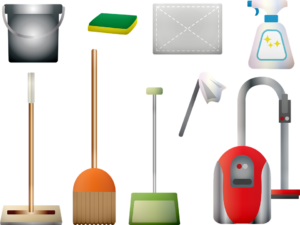
Now may be a good opportunity to support children in becoming more independent in terms of self-care and household tasks.
-
Use chores as a means of reminding children of the importance of good hygiene at all times. Play games where they have to identify the surfaces we touch most frequently and wipe them clean, e.g. door handles, phones/tablets etc./fridge door/toys.
-
Have your child create their own list of daily tasks (a #hinchlist if you will for those who follow Mrs. Hinch) and celebrate as they tick these off. Lists need not be confined to cleaning! Household tasks on the list could include:
-
Hanging out the washing
-
Folding laundry
-
Washing dishes or filling the dishwasher
-
Setting the table
-
Preparing meals
-
Sweeping/mopping
-
Washing the car
-
Washing the windows
-
Rearranging their bedroom
-
Going through their wardrobe and finding clothes they no longer wear to give to charity or to someone younger.
-
Tidying toys and putting away some of those they no longer play with. (Sometimes children have so many toys, the choice is overwhelming for them. Rotating toys by putting some away for a few weeks and then swapping them with others can be a good way to overcome this.)
Other

-
Activity Books:
-
Word-searches
-
Dot to dots
-
Sudoku
-
Paint by Numbers
-
-
Try a Rubiks Cube or similar
-
Build something out of Lego and tell a story about it.
-
Try a mix of writing tasks – look out for our suggestion list coming soon
-
Make a time capsule recording what life is like at this time and bury it.
-
Create a scrapbook
-
Organise photographs in a photo album and write captions
-
Research and write about the place you live in.
-
Draw a map of the place you live in.
-
Do some DIY science experiments
-
Have a pillow fight
-
Build a den
Movement
-
Refer to our ‘Move it, Move it’ post for movement ideas and suggestions for indoors and out.
I hope this list is helpful and offers some suggestions for supplementing the work and activities you already undertake with your children so that they are kept busy and learning during these school closures. As ever, I am here to offer advice and help if needed on teaching activities and topics.
Parents always have been, and always will be, their child’s most important teachers. Teachers work in partnership with parents to supplement this. Although the nature of the partnership and the form of the schooling has changed, as teachers we are here to continue to support and offer back-up and help. I believe I speak for my teaching colleagues when I say, the happiness and success of your children is to the fore in our minds.
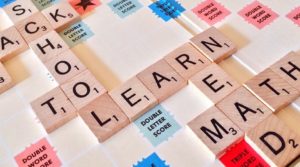
Take care and stay safe all!
Image Source: Pixabay

Pingback: Positive Planning for Homeschooling: A Beginner’s Guide from Dumond
Pingback: An Analogy to Explain why we #StayHome. Beauty in a Bear by Nancy L. Ogilvie.
Pingback: Promoting Speech, Language and Communication at Home
Pingback: World Autism Awareness Day – Information, Resources and Tips
Pingback: 5 + 5 Activity Resource (No. 2) – 5 Independent & 5 Cooperative Learning Activities to Try!
Pingback: Dumond Education’s EPIC List of Homeschooling Resources! – Dumond Education